Organizational Writing Methods for Messy Minds

Long-time Wrimo and soon-to-be published author Anna-Maria Ninnas is a Project Manager with a talent for organizing chaos into coherence. She has been test-driving software to find novel solutions for myriad rampant writerly woes and has put together this comprehensive overview to share some of her best technology-based tips with the community!
Sometimes, you need to put your creativity inside a box.
This couldn’t be more true for writers with a messy mind. The limitless possibilities of a blank page makes me freeze up. However, tell me to create a story out of the magnets on my fridge or using only Cards Against Humanity, and suddenly the limitations of these microcosms give me both a starting point and some rules to activate the brain’s problem-solving function. It takes a shelf to organize your stuff, and the same goes to your writing.
Which is why I love using digital tools and story progression ‘rules’ to find the right crooked mile to weaponize my hyper brain. Today, I’d like to share some of my tricks and digital workspaces with you.
For me, taming my buzzing brain always starts with Trello. I can just move the cards around, like I’m solving a puzzle, which is extremely satisfying and fun. By gamifying the untangling process, I find myself super focused with a visual aid for problem solving. It’s amazing for non-linear thinkers.
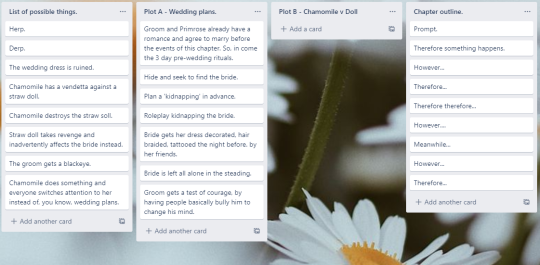
Here we have Chapter 6 of my current manuscript, Chamomile. I began the first draft by dumping everything that happens or could happen in this chapter. Just go crazy! If you have more than one subplot going on, you’ll love this. For me, Plot A is my young character Chamomile being at war with a vengeful straw doll. Plot B, the village is celebrating a wedding. Later I will ‘braid’ these two plots together, to have the paranormal events of Plot A ruin Plot B by all means possible.
When figuring out the flow, one of my favorite techniques is Therefore/However. It helps to figure the logic and flow of events step-by-step, ensure that consequence always follows, and dictate tension! Sometimes I’ll break the rule with more than one ‘therefore’ consequence, or a ‘meanwhile’ when intertwining a secondary subplot. Keep it as simple as cause-and-effect if you’re still trying to figure out how something could happen and why. Eventually, you’ll have an outline that might or might not look like mine:
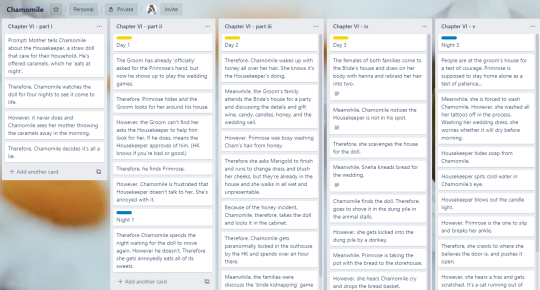
You can utilize colored labels for characters, section breaks, or even a green-yellow-red system for every card to track your passive, urgent and action voice.
But let’s say you’re editing or on a #JustFinishIt marathon. Well, your Google account already has all the tools to tame your focus in a single window.
Opening your blessed auto-saving Google Doc, by default you should find the holy trinity of organizing — Calendar, Keep, and Tasks.

I love Keep for its simplicity. If I’m on the go and come up with the perfect line, find inspiration or remember a loophole to edit later, I whip out my phone, save, move on. I use labels only to separate my novels, occasional hashtags.
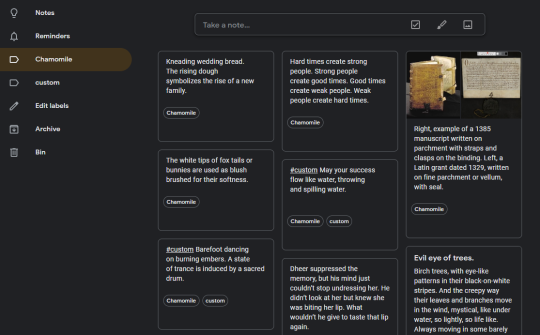
The beauty of it is that you can use Keep while you’re in Docs. Since you’re guaranteed to get distracted, why not use it to your advantage by choosing what you’re distracted by — like scrolling your own notes in the sidebar instead of Pinterest! Scrolling social media is addicting because with so little movement we get infinite information, barely losing any calories — your brain loves the efficiency. Get addicted to your novel instead!
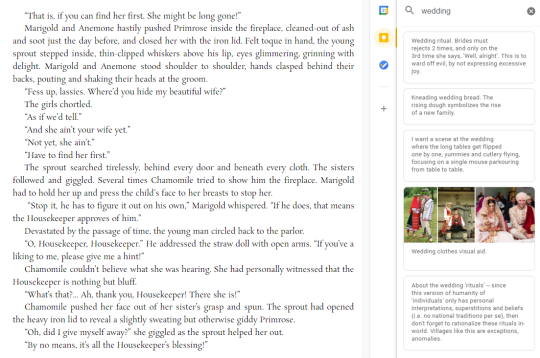
The search tool is not the only benefit. You can cut-and-paste entire sections that ‘don’t work’, but you like and might adapt elsewhere. Slap them there for safekeeping. You can write down a plot bunny, a topic to research, an important reference to keep in mind for Chapter 23, a new idea or editorial notes. Multitasking is a breeze. Pin the notes you find most relevant right now to the top. Notes you create while in the Doc automatically tags it as ‘related’, so later in Keep you can filter notes related only to that one chapter — which is why I separate my chapters doc-by-doc!
Google Tasks are amazing for editing. You can make the checklist as you re-read after a break, a list for each chapter, so you can later go back and — oh yes — tick the boxes off one by one, knowing exactly what you’re doing, to fix loopholes and add missing elements.
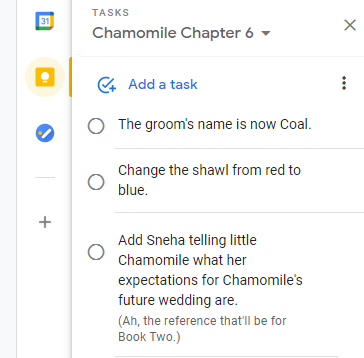
Last but not least is the simple genius of Calendar. If you have multiple plotlines, characters, or maybe even time-travel involved, then the overlapping schedules of Google Calendar—which, yes, you can drag and reorder—is gorgeous. Now, because all these methods are pick-and-choose on a need-to-untangle basis, I wasn’t using it in this chapter much. However, it did come to help when I was trying to figure out the time window just before Chamomile gets into trouble—again—when it was time to leave the bride home alone as a test of patience, to justify how she ended up babysitting instead. (Because you had to go into the storeroom in your wedding dress, Primrose, and now you have to wash the dress. What a convoluted way to break your ankle tonight before your wedding.)

And this is just a recent, as-I-do-it example of some ways I handle my comprehension of my own story! Would you have adapted these tools differently? While it may look over-complicated to some, for me it’s the only way I can tame my head when ‘sit down and write’ sounds impossible, and I know I’m not alone.
There are many free and subscription apps you can use to organize your writing. Try them, make use of tech! Find your carton ‘box’ that’ll unleash your creativity and help you build forts. Once you discover how that beautiful mind of yours expresses itself and find an analogous method to translate it, trust me, your craft will bloom.

Anna-Maria Ninnas studies anthropology and contemplates humanity through the lens of fiction. A project manager by vocation but extremely unorganized by nature, Anna-Maria tries to hack the art of writing with all sorts of cheats, methods and problem-solving techniques. You can read Anna-Maria’s tips for all the other chaotic creative minds on Medium. The novel Chamomile is coming out April 2022 no matter how messy or unfinished it is!
Top photo by Ross Sneddon on Unsplash
Chris Baty's Blog
- Chris Baty's profile
- 63 followers



